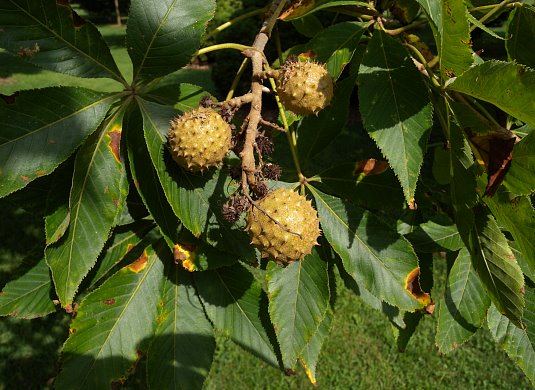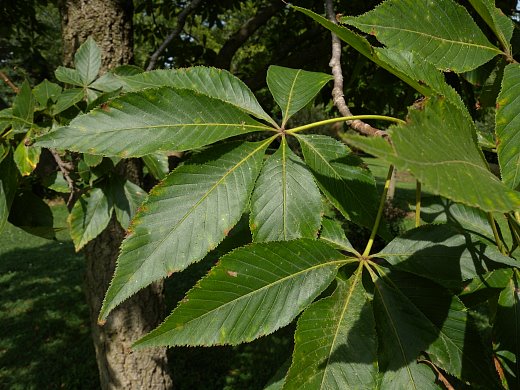Description: This tree is about 40-60' tall, forming a single trunk about 1-2' across and a much-branched ovoid crown. At optimal sites, larger trees have been found exceeding 70' tall. The trunk bark is gray and rough-textured, becoming scaly, warty, and slightly furrowed with age. The bark of branches and twigs is gray and smooth. Pairs of opposite compound leaves are produced from young twigs. These leaves are palmately compound with 5-7 leaflets. The slender petioles of the compound leaves are 3-6" long, light green, and glabrous. Individual leaflets are 3-6" long and 1-2" across; they are elliptic or elliptic-oblanceolate in shape, serrated along their margins, and nearly sessile. The upper surface of the leaflets is medium to dark green and glabrous, while the lower surface is pale green and usually hairless; sometimes there are tiny hairs along the lower ribs of the central veins.

Elongated panicles of flowers about 4-8" long are occasionally produced near the tips of the smaller branches. The upper flowers of a panicle are primarily staminate (male), while the lower flowers are primarily perfect (both male & female). Individual flowers are about ¾–1" long, consisting of 4 greenish yellow petals, green to yellowish green tubular calyx with 5 rounded lobes, 7 strongly exerted stamens, and (for perfect flowers) a pistil with a single exerted style. The petals are held more or less parallel to each other, although the tips of the upper petals may turn upward when a flower is receptive to pollination. Sometimes there is a reddish patch near the base of each upper petal. The stalks of the panicle are light green, becoming tan-colored later in the year. The blooming period occurs from mid- to late spring and lasts about 2-3 weeks. Usually, only 1-3 perfect flowers in a panicle will develop into seed capsules, which ripen during the fall. Individual seed capsules are 1½–2" across, globoid in shape, and conspicuously prickly. At maturity, the leathery shell of each seed capsule splits open into three parts to release 1-2 large seeds (rarely 3). Individual seeds are about 1–1½" across and more or less globoid in shape; when a capsule contains more than one seed, they are sometimes partially flattened along one side. Each mature seed is dark brown and shiny with a tan-colored "eye" at its apex. The woody root system produces a taproot and lateral roots. This tree reproduces by reseeding itself.
Cultivation: The preference is full sun to light shade, moist to mesic conditions, and soil containing loam, silt-loam, or clay-loam. This tree should be planted in an area that is protected from prevailing winds, excessive heat, and air pollution, otherwise the leaves may become scalded and diseased. The large seeds can be germinated by planting them in the ground during the fall, or by storing them in moist sand in a refrigerator for 90-120 days (cold stratification). Seeds that are allowed to dry out will lose their viability and fail to germinate.
Range & Habitat: The native Ohio Buckeye is occasional in most areas of Illinois, except in the NW section, where it is absent from natural areas (see Distribution Map). Habitats include moist to mesic deciduous woodlands, wooded valleys along rivers, and rocky wooded slopes in sheltered areas. Ohio Buckeye is sometimes cultivated as a landscape tree.
Faunal Associations: The flowers are pollinated primarily by the Ruby-Throated Hummingbird and various long-tongued bees, including bumblebees (Bombus spp.), long-horned bees (Synhalonia spp.), mason bees (Osmia spp.), and Anthophorine bees (Anthophora spp.). Occasionally smaller bees (Halictid bees, Andrenid bees) also visit the flowers. These floral visitors seek primarily nectar, although some bees also collect pollen (Robertson, 1929; Wilhelm & Rericha, 2017; Krombein et al., 1979). Several kinds of insects feed destructively on the leaves, bark, plant sap, and other parts of Buckeye trees (Aesculus spp.); this includes beetles, leafhoppers, armored scale insects, mealybugs, larvae of moths, and a thrips (Heterothrips aesculi). Ohio Buckeye is a preferred host plant of several leafhoppers, including Eratoneura bifida, Eratoneura fulleri, Eratoneura protuma, Eratoneura rubranotata, Erythridula aesculella, Erythridula crevecoeuri, and Erythridula rubroscuta. The Insect Table has a more complete list of these insect feeders. Because the large seeds are poisonous, they are rarely consumed by wildlife. However, the Eastern Fox Squirrel has been known to eat the seeds sparingly (Martin et al., 1951/1961; Wilhelm & Rericha, 2017). This tree squirrel also feeds on the pith of twigs occasionally, which contains a sugary substance. White-Tailed Deer wisely avoid this tree because of its poisonous leaves and bark, which produce a fetid smell when they are crushed. Sometimes cattle and other domesticated animals feed on the leaves, twigs, or nuts, and successfully manage to poison themselves in the process. Ohio Buckeye is sometimes selected as a summer roost tree by the Tricolored Bat (Perimyotis subflavus). A native plant with an arboreal habit, Eastern Mistletoe (Phoradendron leucarpon), sometimes parasitizes Ohio Buckeye, but it does not cause significant damage to the tree. This parasitic plant produces sticky white berries that are eaten and distributed by birds.

Photographic Location: The Arboretum at the University of Illinois in Urbana, Illinois.
Comments: Ohio Buckeye is the only member of its genus that is widespread in Illinois. It can be distinguished from other Aesculus spp. by one or more of the following features: the color of its flowers (greenish yellow), the exserted stamens of its flowers, the number of leaflets per compound leaf (5-7), the shape of its leaflets (see preceding photos & description), the prickliness of its seed capsules, and its overall size (a moderate-sized tree). For example, an introduced tree, Aesculus hippocastanum (Horse Chestnut), has white flowers with reddish patches and its leaflets are more oblanceolate or obovate with short obtuse tips. A species that is native to southern Illinois, Aesculus pavia (Red Buckeye), differs from Ohio Buckeye by its red flowers, smooth seed capsules, and shrubby habit.